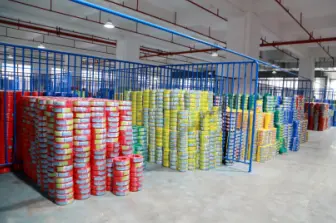The Difference Between Fire Retardant Cable and Ordinary Cable
Ⅰ. The difference between flame retardant cables and ordinary cables
Flame retardant cables are different from ordinary cables in terms of insulation and sheath. Flame retardant cables are suitable for being burnt out and unable to operate in a fire situation, but the flame spread is only within a limited range, and the residual flame or residual burn can be extinguished by itself within a limited time, which can prevent the spread of the fire. If the cable catches fire, the combustion can be limited to a local area without spreading, and other various equipment can be protected to avoid greater losses. Flame retardant cables can be used in ships, metallurgy, electric power, petrochemical and other industrial and mining enterprises, as well as buildings, public places and other places where fires may occur. So, what does an ordinary cable look like? Ordinary cables are ordinary cables and have no flame retardant properties, so you can choose them according to the conditions of use. It can be a polyethylene sheath material or a polyvinyl chloride material according to the customer's own situation.
The meaning of flame retardant: under the specified test conditions, the sample is burned. After the fire source is removed, the flame spreads on the sample only within a limited range and extinguishes itself, which has the characteristics of preventing or delaying the occurrence or spread of flame ability.
Ⅱ. The low-halogen and halogen-free flame retardant of flame retardant cables
The combustion of wires and cables is caused by external heating to produce flammable gas. To achieve the purpose of flame retardancy, the three elements that cause combustion must be suppressed, namely flammable gas, heat and oxygen. Therefore, the method generally used for flame retardant cables is to add halogen-containing halides and metal oxides to the sheath material. This is an excellent method to evaluate from the perspective of flame retardancy. However, because these materials contain halides, It releases a large amount of smoke and hydrogen halide gas during combustion, so the visibility during fire is low, which greatly hinders the safe evacuation of personnel and fire fighting, and people are more suffocated to death by toxic gases. In addition, once the hydrogen halide gas reacts with water in the air, hydrohalide acid is generated, which severely corrodes equipment and buildings and causes secondary disasters.
At present, with the continuous improvement of the level of science and technology, the flame retardant problem has been further developed from the halogen flame retardant in the past to the low halogen, halogen-free flame retardant. The insulation and sheath of the cable are made of low-smoke, halogen-free, high-decomposition temperature, and halogen-free polymer materials with good mechanical properties. Because the cable does not contain halides and metal oxides, the fire retardant cable will not produce harmful gases and A large amount of smoke does not have the possibility of causing secondary disasters, and it also has good mechanical and electrical properties, which meets the requirements of the use of cables, and completely changes the deficiencies of the previous flame retardant cables.
Latest News & Blog
 English
English  français
français  Deutsch
Deutsch  العربية
العربية  tiếng việt
tiếng việt  ไทย
ไทย  čeština
čeština  Indonesia
Indonesia  Eesti
Eesti  български
български  slovenčina
slovenčina 



